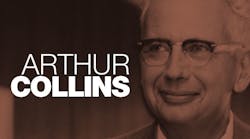Throughout history, seemingly ordinary men and women have achieved extraordinary things. One such person was Arthur A. Collins. While a select few may have realized his potential at the time, the young Collins appeared to be no different from the other boys who grew up in his hometown of Cedar Rapids, Iowa.
"We sensed that Arthur was different, but we did not know that he was a genius," a former neighbor told The New York Times in 1962. "When the rest of us were out playing cowboys and Indians, Arthur was in the house working on his radios."
Perhaps one of the earliest hams, Collins obtained his amateur radio license from the Federal Radio Commission (now the FCC) in 1923 at the age of 14. Collins' passion for radio was sparked six years earlier when he and a childhood friend, Merrill Lund, made their first crystal receivers using Quaker Oats tubes that Lund's father brought home from work.
While his first receivers were rudimentary, Collins' equipment proved to be so well made that the 16-year-old was able to establish a communications link with Navy commander Richard E. Berd during his exploration of Greenland in 1925—a feat that the U.S. Navy struggled to accomplish.
Out of the basement, into the world
The now-famous amateur went on to manufacture transmitters to order in his basement. In 1932, ads of varying sizes for Collins' radio transmitters appeared in the radio enthusiast magazine Radio Age. Less than a year later, Collins founded the Collins Radio Company.
For the first few years, Collins Radio catered to the amateur radio hobbyist. By the end of the 1930s, however, the company had added the production of commercial broadcast radio equipment to its amateur transmitters.
In 1940, Collins Radio began work on its first military contract. The ART-13 transmitter featured a permeability tuned oscillator (PTO) and employed a proprietary technique called Autotune to preprogram up to 10 frequencies.
During its heyday, the Collins Radio Company employed more than a thousand workers in its Cedar Rapids factory alone, which opened in 1933 with just one employee at the height of the Great Depression. (Production sites were opened in Burbank, Calif., in 1946 and Dallas, Texas, in 1950).1 The company had such a dramatic effect on the Cedar Rapids economy that generations of men, and eventually women, would come to work at Collins' flagship facility for years to come.
"There are boys and girls in our schools and colleges who firmly believe that Collins Radio is part of their own family, because in their lifetime, it has been a source of income, a sense of security, for their parents," said Arlo Goodyear, a former Collins Radio employee.1
"With the war years, there was scarcely a family who was not represented directly or at least was well acquainted with an employee," Goodyear continued. "In a few short years, Collins Radio became an institution in the community. Many came for employment because they felt they could do their bit to help a loved one in the service; many more came because they were lured by the upturn of wage scales."
Ahead of its time
By many accounts, the Collins Radio Company was ahead of its time. While Americans continued to struggle to find work, employees at Collins Radio were awarded overtime pay and coffee breaks.2
"It is worthy to note that Collins has never had a major labor difficulty," said Goodyear, "and not one man-hour has ever been lost because of strikes."
In 1951, the military contracted the Collins Radio Company to produce the R-390 receiver, which operated in the 0.5- to 30-MHz range and featured a direct mechanical digital frequency readout. By some accounts, 16,000 R-390s were produced for the military at $2500 each.2
From that point on, Collins Radio served as a regular contractor to various arms of the U.S. government. In 1952, in cooperation with the National Bureau of Standards, Collins sent the first long-distance message that utilized the moon as a reflector. Four years later, Time magazine reported that military planes traveling over the North and South Pole were able to communicate using Collins Radio equipment. And in the 1960s, the company supplied communications equipment used for the Apollo, Gemini, and Mercury space programs.1
While the government continued to order equipment en masse for more than 20 years, the company nearly went bankrupt in the late 1960s (despite the fact that by 1961, Collins owned 623 U.S. patents).1 At one point, former presidential candidate Ross Perot's Texas-based Electronic Data System Corp. reportedly attempted to take over Collins Radio.1 In 1971, though, the company merged with Rockwell International Corp., with Collins serving as president and chair of the board. Collins Radio products continued to be manufactured under Rockwell International until 2001, when Rockwell Collins Inc. spun off from its parent corporation. Today, 60 Rockwell Collins locations in 27 countries produce aircraft electronics for airlines around the world. According to the company, nearly 70% of all U.S. and allied military airborne communication uses its electronics.
While Collins' namesake is now associated with high-quality communications and aviation electronics, the man who founded the Collins Radio Company will always be remembered by fellow hams for his contributions to a pastime that continues to intrigue more than 2 million amateur radio operators around the world today.
References
- collinsclubs.com, Company Timeline, www.collinsclubs.com/history/timeline
- wikipedia.org, Collins Radio Company, en.wikipedia.org/wiki/Collins_Radio
